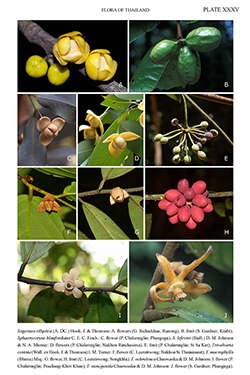e-Flora of Thailand
Volume 16 > Part 1 > Year 2022 > Page 284 > Annonaceae > Sphaerocoryne
3. Sphaerocoryne lefevrei (Baill.) D.M.Johnson & N.A.Murraywfo-1000029028
in D.M.Johnson et al., Thai Forest Bull., Bot. 49(2): 170. 2021.— Melodorum lefevrei [‘lefevriiʼ] Baill., Adansonia 10: 108. 1871. Fig. 61. Plate XXXV: D–E.
Accepted Name : This is currently accepted.
Synonyms & Citations :
Description : Shrub or small tree up to 8 m tall. Twigs glabrous. Leaves subcoriaceous to chartaceous, concolourous or slightly paler below, elliptic to oblong, rarely lanceolate, 7.9–12.4 by 2.9–3.4(–4.3) cm, base cuneate to broadly cuneate, apex acute, obtuse, or short-acuminate, the acumen 3–12 mm long, glabrous on both surfaces, secondary veins 10–14 per side; petioles 4–8 mm long. Inflorescences axillary or pseudoterminal, 1-flowered, pedicels 13–35 mm long, bearing 1 bract ca 1 mm long, often bent near the point of bract attachment. Sepals connate at base, semicircular, 3–4.5 mm long, acute, glabrate. Petals cream-coloured, yellow, or yellow-brown, fleshy; outer petals ovate, 7–15 by 9–10 mm, broadly acute; inner petals ovate, 6.5–11 by 7–9 mm, concave, broadly acute. Stamens clavate, 1.7–2.1 mm long, anther connective apex truncate to convex. Carpels 25–30, ovaries tomentose [ex Sinclair]. Receptacle disk-like, 1.5–2 mm high, ca 3.5 mm in diam. Fruit of up to 28 monocarps borne on a pedicel ca 38 mm long. Monocarps dark purple with reddish stipes when mature, ellipsoid (1-seeded) to oblongoid (2-seeded), 0.8–1.1 (2-seeded 1.1–1.6) by 0.5–0.9 cm, glabrate, apex rounded and sometimes apiculate, stipe (9–) 20–26 by ca 0.8 mm; pericarp membranous, ca 0.5 mm thick. Seeds 1–2, attached sub-basally if 1, laterally if 2, ellipsoid, 7–9 by 5.2–6.4 mm, smooth, tan-coloured.
Thailand : NORTHERN: Chiang Mai (cultivated); NORTH-EASTERN: Nakhon Phanom, Khon Kaen; EASTERN: Chaiyaphum, Nakhon Ratchasima, Buri Ram, Si Sa Ket; SOUTH-WESTERN: Prachuap Khiri Khan; CENTRAL: Saraburi, Krung Thep Maha Nakhon (Bangkok) (cultivated – type of Popowia mesnyi Craib: Murton 30, not traced); SOUTH-EASTERN: Sa Kaeo, Chachoengsao, Chon Buri (type of Popowia mesnyi Craib: Collins 6 -TCD), Rayong, Chanthaburi, Trat; PENINSULAR: Phangnga (cultivated).
Distribution : Laos, Cambodia, Vietnam (type).
Ecology : Mixed deciduous forests, 50–510 m alt. Flowering: February–April; fruiting: March–April and June–July.
Vernacular : Hom nuan (หอมนวล)(Northern); lam duan (ลำดวน)(Central); lam duan dong (ลำดวนดง).
Uses: Sphaerocoryne lefevrei is popular as an ornamental and is often cultivated outside its native region. A cultivar with red-tinted flowers appears in the horticultural trade in Thailand. The flowers of S. lefevrei are a familiar symbol, represented in cookies, earrings and other decorations. The fruits are eaten in Thailand, Cambodia, and Vietnam.
Notes: The pendent fragrant flowers, with the inner petals closed over the centre of the flower at anthesis, are familiar throughout Thailand. The species has long been known by the name Melodorum fruticosum Lour., now accepted as a taxonomic synonym of Uvaria siamensis (Scheff.) L.L.Zhou, Y.C.F.Su & R.M.K.Saunders. Sphaerocoryne lefevrei, which is typically a small tree or shrub, is quite similar to the climbing species S. affinis, and the two species have sometimes been combined. Sphaerocoryne lefevrei has leaf blades that tend to be narrowly elliptic and acute to short-acuminate, while those of S. affinis are lanceolate with a more pronounced acumen. The two species have different but partially overlapping size ranges for several other characters: in S. lefevrei the petioles are 4–8 mm long, the sepals 3–4.5 mm long, the inner petals 6.5–11 mm long, and the floral receptacle 1.5–2 mm high and ca 3.5 mm in diam., while in S. affinis the petioles are 2.5–4.5 mm long, the sepals 2–2.7 mm long, the inner petals ca 6 mm long, and the floral receptacle ca 1 mm high and 1.2 mm in diam.


